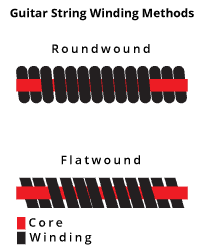Which Guitar Strings Should I Use?
I remember when I first started playing, I was confused by the string sizes and what to use on my guitar. Luckily for me I had a living encyclopedia of guitar playing knowledge in my house. Not everyone is so lucky and everyone has a preference. Everyone has a recommendation. What’s a fledgling guitarist to do? Well first off remember that guitar strings are like most other things when it comes to guitar playing. It’s a preference based on What kind of guitar you are playing, what you like tonally, What feels good and what you are playing. I said this about guitar picks and I’ll say it again about strings, the best thing you can do is try as many kinds as you can until you find what you like. Having said that there are some things to consider.
Sizes
Guitar strings are often referred to by the size or gauge of the Bottom or high E string. Common theory is that the bigger the string the more sustain you will get. The main drawback is the difficulty in bending them or playing them for extended periods of time. Many of todays modern guitarists use the “Drop D” tuning and 13’s are prime for that. Thicker gauge strings are also great for tuning down a half step, which is exactly what players like Jimi Hendrix and Stevie Ray Vaughan did. For reference Stevie Ray Vaughan is said to have played “13’s” which are pretty large as guitar strings go. So many of us mere mortals use smaller gauge strings.
| String | 8’s | 9’s | 10’s | 11’s | 12’s | 13’s |
| E | .008 | .009 | .010 | .011 | .012 | .013 |
| B | .011 | .011 | .013 | .014 | .016 | .016 |
| G | .014 | .016 | .017 | .018 | .024 | .026 |
| D | .022 | .024 | .026 | .028 | .032 | .036 |
| A | .030 | .032 | .036 | .038 | .042 | .046 |
| E | .038 | .042 | .046 | .049 | .052 | .056 |
Smaller strings have less sustain than the bigger ones but they are easier on your hands and are easier to bend when playing solos.
String Gauges vary widely but normally measured in thousandths of an inch from .008 on up to .013
Acoustic players usually use somewhere between .010 and .013 I actually use a .011 for mine which is considered light by many. Using a thicker gauge will also help you get a richer “fuller” tone. A larger gauge string will also help your acoustic guitar to project or help to increase the volume when playing. This is really nice when at a jam session with multiple guitarist. That extra volume helps you to cut through just a little bit better.
Electric Players use strings that run the whole gamut of sizes from .008 on up to .013 or larger for some. I personally use .010’s and .011’s on my electrics. The same applies to electric as acoustic. They have a big “fat” tone with lots of bottom end. I have heard players describe the virtues of thicker strings by saying they ring like a bell describing the large amount of sustain and bigger sound they produce.
As a new guitar player I would recommend starting with a .010. One reason is it’s pretty much right in the middle. Another seems pretty stupid but I remember when I was first starting I snapped off tons of .008’s and .009’s while attempting to clumsily tune my guitar and getting that high E string way too sharp. When that happens its frustrating and costly as you have to go find a single high E string or open a whole other set. I musta snapped off a couple hundred of them until I figured out how to use an electronic tuner. (Which I highly recommend getting) Once your “ear” develops and you can hear when your going sharp the snapping stops. I Promise!
Winding
Round Wound, Half Round or Flat Wound. I think I’ll be giving more info on these in the future but since I’m trying to help the beginner guitar players out there. I’m going to assume that most of you will want the round wound. Half and Flat Wound are for more advanced guys that really know what they want and these strings give them that. Stick with the round wound for now.

What they are made of:
Acoustic strings
You can find strings for your acoustic in Bronze and Phosphor Bronze.
Initially I would recommend going with Bronze. They are much brighter sounding then the warmer phosphor bronze strings. I’ve never seen any research on this but friends who play around the ocean say that the phosphor bronze resist corrosion better then regular bronze. For them the phosphor bronze strings are the winner. Since I live closer to the Great Lakes than the ocean with a noticeable lack of salty sea air I’ll stick with the bigger sounding Bronze myself.
Electric Strings
Electric Strings construction is equally important to that of the acoustic strings. Many varieties exist. Once again the only way to know is to try them. Electric strings are usually made of stainless steel or nickel. Since the pickups use magnets in order to transmit the sound the string makes it’s important that the strings are constructed of some magnetic metal.
Nylon strings
Nylon strings are a whole other animal largely because they are not measured the same way as metal strings. They are measured by pounds of tension instead of the thickness of the metal strings. I’ll be doing a separate shorter (hopefully) article on them in order to give you a better idea if you need these.
How can I make my guitar strings last longer and when should I change them?
A good periodic change of strings breathes new life in to any guitar. You won’t believe the difference it makes. Once your strings start to feel “Cruddy” change them. If you can see rust, corrosion or look tarnished, change them. If someone picked up your guitar after eating a bag of potato chips and they don’t seem to come clean, change them. If they are rusty and feel like they are about to cut your fingers open while you play it’s probably time to change them.
The best piece of advice I’ve ever gotten on how to keep my strings longer is the very same that a doctor gave me to keep me from getting sick. “Hand washing is the best prevention”. In this case washing your hands before playing helps to keep the grime down on your strings and helps with preventing your strings from needing changed all the time instead of getting sick but, it works just the same. Another thing you can do is get some of those real nice and soft baby blankets. Keep it in your guitar case. When you are done with a gig, practice or jam, Wipe the guitar down. It helps to keep the “Finger Funk” down. “Finger Funk” was how my stepfather described the dirt that gathered on your guitar strings after you played.
One other thing that I personally like is using a product made by GHS called Fast Fret. In addition to washing my hands before I play and wiping down the strings I use Fast Fret. I put it on and wipe it off after the inital wipe down of my guitar and strings to remove the “Finger Funk”. Not to sound like a commercial for them but I’ve used it for years and it seems to do exactly what it says it does. Cleans Strings, I don’t know about playing faster but in my opinion it seems to feel as though I play smoother with a little less effort. It also appears to help keep my fingerboard clean as well. If someone were to ask me I would gladly recommend this product to any guitarist.
Other Considerations:
On string size.
Many times if purchasing electric strings once you get into the 12’s and 13’s be aware that you may wind up with a wound G string. This means if you are like me and cant stand a G string with winding around it you will need to find a way to get the proper size or very close to it without winding. This is not always the case but make sure before you buy a set to look for this.

Recent Comments